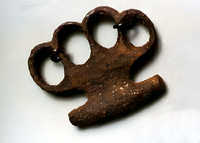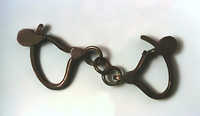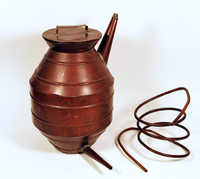Rum Car Wrecked After Gun Fight with Officers
Portland Evening Express, March 18, 1927
Violence gained a new mobility that often matched more urban places, including this running gun battle from Scarborough to South Portland.

Prohibition cartoon, ca. 1925
Maine Historical Society
Prohibition's effectiveness in Jackman and Quebec, ca. 1920
William Norman Ritche
Pen and ink cartoon
Collections of Maine Historical Society
Born in Canada, "Norman" was a long-time contributor to the Boston Post. In Canada the War Measures Act (1916-1919) banned alcoholic beverages. After the war, Quebec became wet, with Ontario following in 1927. The French Island of St. Pierre & Miquellon became a major entreport for Canadian and American rum runners.
"After the last box [alleged to be bootlegged alcohol] had been stowed in the truck, the two Donahues were escorted out the door between a pair of G-men. They received a tremendous ovation from the crowd who cheered and waved at them."
Harold Boyle, The Best of Boyle , 1980

Suspected Rum Runner Dixie III, Portland, 1927
Maine Historical Society/MaineToday Media
Suspected Rum Runner Dixie III, tied up at Portland wharves, 1927
Collections of Maine Historical Society/Maine Today Media
Coll. 1949; 2005.061.14591
Like its large counterparts, Boston and New York, Portland also had its "rum row," an area outside the U.S. territorial 3-mile limit where large vessels lined up and sold liquor to small, fast boats like this one which brought the liquor to shore. Building such craft for bootleggers brought a brisk business to Downeast boatyards.

Prohibition liquor hiding techniques: Victrola before, Portland, ca. 1922
Maine Historical Society/MaineToday Media

Victrola converted into liquor storage, Portland, ca. 1922
Maine Historical Society/MaineToday Media
Deputy with Victrola/Liquor Cabinet
Portland, 1922
Collections of Maine Historical Society/Maine Today Media
Coast Guards Fire Truck with Bullets on Brunswick Road
Portland Evening Express, October 16, 1934
Even after Repeal the illegal liquor traffic continued to thrive.
Overturned automobile
Collections of Maine Historical Society/Maine Today Media
Coll. 1949; 2005.061.6648
The rising car culture brought speed and accidents to the nations road. Combined with alcohol, this new form of transportation and recreation accounted for an increasing number of deaths. Drunk driving remains a major problem.
Knuckle Dusters
Courtesy of Joyce Butler
These tools of law enforcement were used by a Biddeford policeman during the Roaring 20s.
Handcuffs, ca. 1928
Courtesy of Joyce Butler
Owned by George Butler, Police Commissioner in Biddeford.
Still
Copper
Collections of Maine Historical Society
1998.39 a-c

Cache of liquor, Portland, 1920
Maine Historical Society/MaineToday Media
Illegal whiskey being removed from a vessel in Portland Harbor
Portland, ca. 1920
Collections off Maine Historical Society/Maine Today Media
Booze seemed to arrive from all directions. Only a fraction of the smuggled booty was captured.
Where Do They Go? When They Row, Row, Row
Waterson, Berlin, and Snyder Co., 1920
Collections of Maine Historical Society; gift of Harland H. Eastman, 1998
Sheet music 25
The United States boundary ended three miles away from the shore and large vessels lined up, forming an area called rum row off coastal cities like Portland. Smaller vessels would buy up liquor and try to return to shore undetected.

Confiscated liquor bottles, Portland, 1927
Maine Historical Society/MaineToday Media
Green River whiskey bottles hidden in Moxie cases, 1927
Seized at a Yarmouth Inn
Collections of Maine Historical Society/Maine Today Media
Citizens in Maine and throughout the nation reacted to prohibition in a variety of ways. The majority no doubt, obeyed the laws, but many found ingenious ways to drink, hide, transport, and sell spirits. Illegal roadhouses, kitchen bars, and clubs joined those already operating in violation of state laws
Maine License Plate, 1921
Courtesy of Drew Masterson, originally from Mr. and Mrs. James M. Cameron
Billy club, ca. 1928
Courtesy of Joyce Butler
Owned by George Butler, Police Commissioner in Biddeford.

Brady Gang shooting, Bangor, 1937
Bangor Historical Society
Al Brady and Partner, Gunned Down
Bangor, October 12, 1937
Collections of Bangor Historical Society
The return of ardent spirits, plainly shown by the Ballantine Ale billboard, did not end violence. Brady, Public Enemy Number One, was surrounded by FBI agents, state and local police when he attempted to buy guns at a local sporting goods store.
GALLERIES: Bootleggers vs. Police | Society Copes | Reform and Repeal









